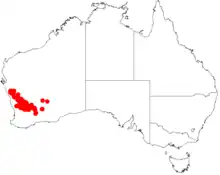| Acacia nigripilosa | |
|---|---|
| Scientific classification | |
| Kingdom: | Plantae |
| Clade: | Tracheophytes |
| Clade: | Angiosperms |
| Clade: | Eudicots |
| Clade: | Rosids |
| Order: | Fabales |
| Family: | Fabaceae |
| Subfamily: | Caesalpinioideae |
| Clade: | Mimosoid clade |
| Genus: | Acacia |
| Species: | A. nigripilosa |
| Binomial name | |
| Acacia nigripilosa | |
 | |
| Occurrence data from AVH | |
Acacia nigripilosa is a shrub belonging to the genus Acacia and the subgenus Phyllodineae that is endemic to Western Australia.
Description
The shrub typically grows to a height of 0.5 to 2 metres (1.6 to 6.6 ft).[1] It has glabrous ash-grey, coloured branchlets. the ascending to erect dull to shiny green phyllodes have a linear to narrowly oblong-elliptic or oblanceolate shape. The phyllodes have a length of 2 to 7 cm (0.79 to 2.76 in) and a width of 1 to 8 mm (0.039 to 0.315 in) and are narrowed at the base.[2] It blooms from July to September and produces yellow flowers.[1] The inflorescences occur singly or in pairs along an axes of 1 to 3 mm (0.039 to 0.118 in). The flower-heads have a slightly obloid shape and contain 18 to 34 golden flowers. The seed pods that form after flowering resemble a string of beads and have a length of 4 to 9 cm (1.6 to 3.5 in) and a width of 4 to 7 mm (0.16 to 0.28 in). the shiny dark brown seeds within the pods have an oblong-elliptic to ovate shape and a length of around 4 mm (0.16 in).[2]
Taxonomy
The species was first formally described by the botanist Joseph Maiden in 1920 as part of the work Notes on Acacias, No. IV, with descriptions of new species as published in the Journal and Proceedings of the Royal Society of New South Wales. It was reclassified in 2003 as Racosperma nigripilosum by Leslie Pedley then transferred back to the genus Acacia in 2006. The only other synonym for this species is Acacia nigripilosus.[3] There are two recognized subspecies:
- Acacia nigripilosa subsp. latifolia
- Acacia nigripilosa subsp. nigripilosa
Distribution
It is native to an area in the Mid West, Goldfields and Wheatbelt regions of Western Australia where it grows in sandy soils around laterite.[1] It is found as far north as around Yuna south to around Goomalling and east out to Mount Holland where it is found in scrubland or open woodland communities.[2]
See also
References
- 1 2 3 "Acacia nigripilosa". FloraBase. Western Australian Government Department of Biodiversity, Conservation and Attractions.
- 1 2 3 "Acacia nigripilosa". World Wide Wattle. Western Australian Herbarium. Retrieved 15 May 2019.
- ↑ "Acacia nigripilosa Maiden". Atlas of Living Australia. Global Biodiversity Information Facility. Retrieved 15 May 2019.